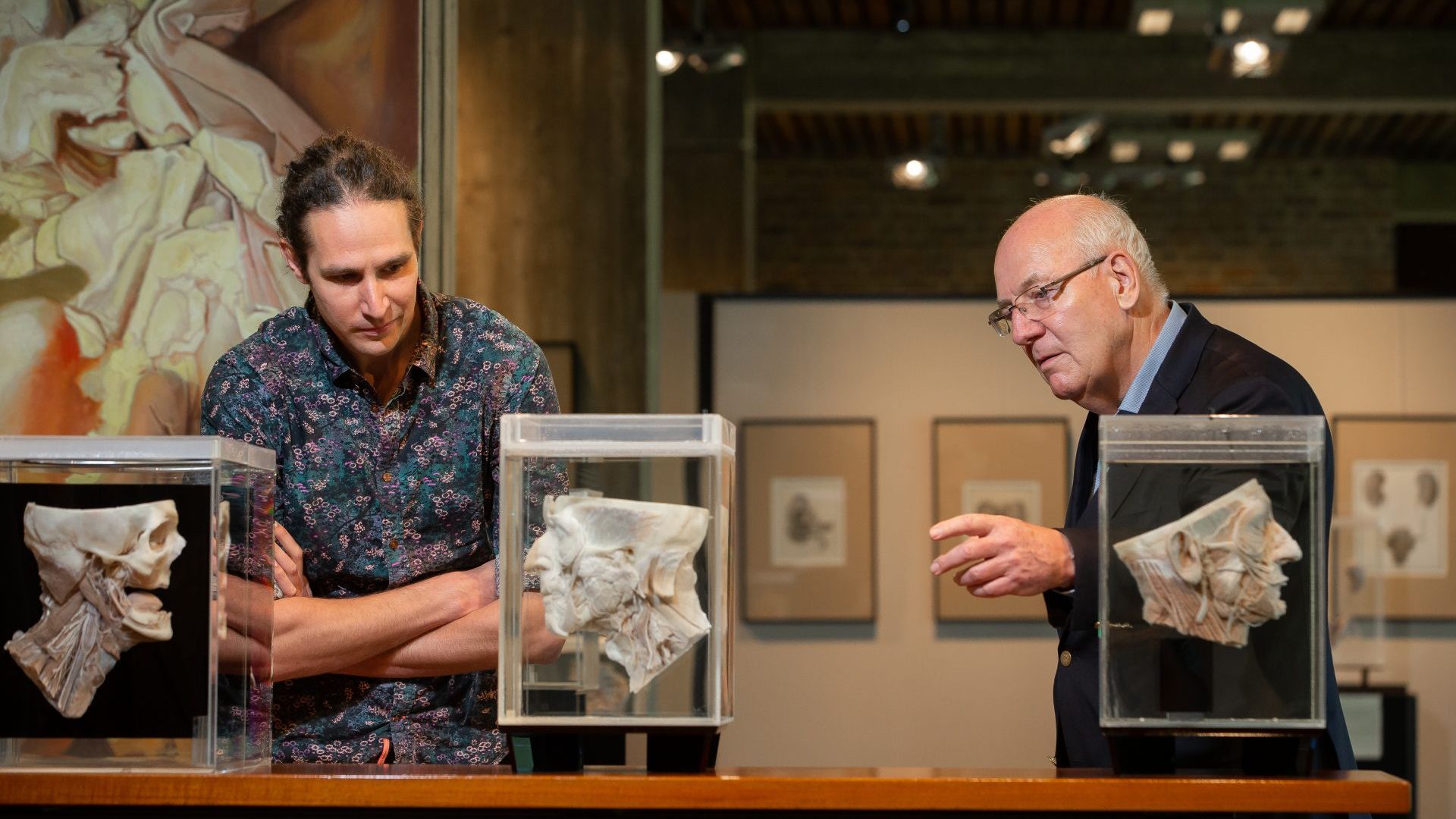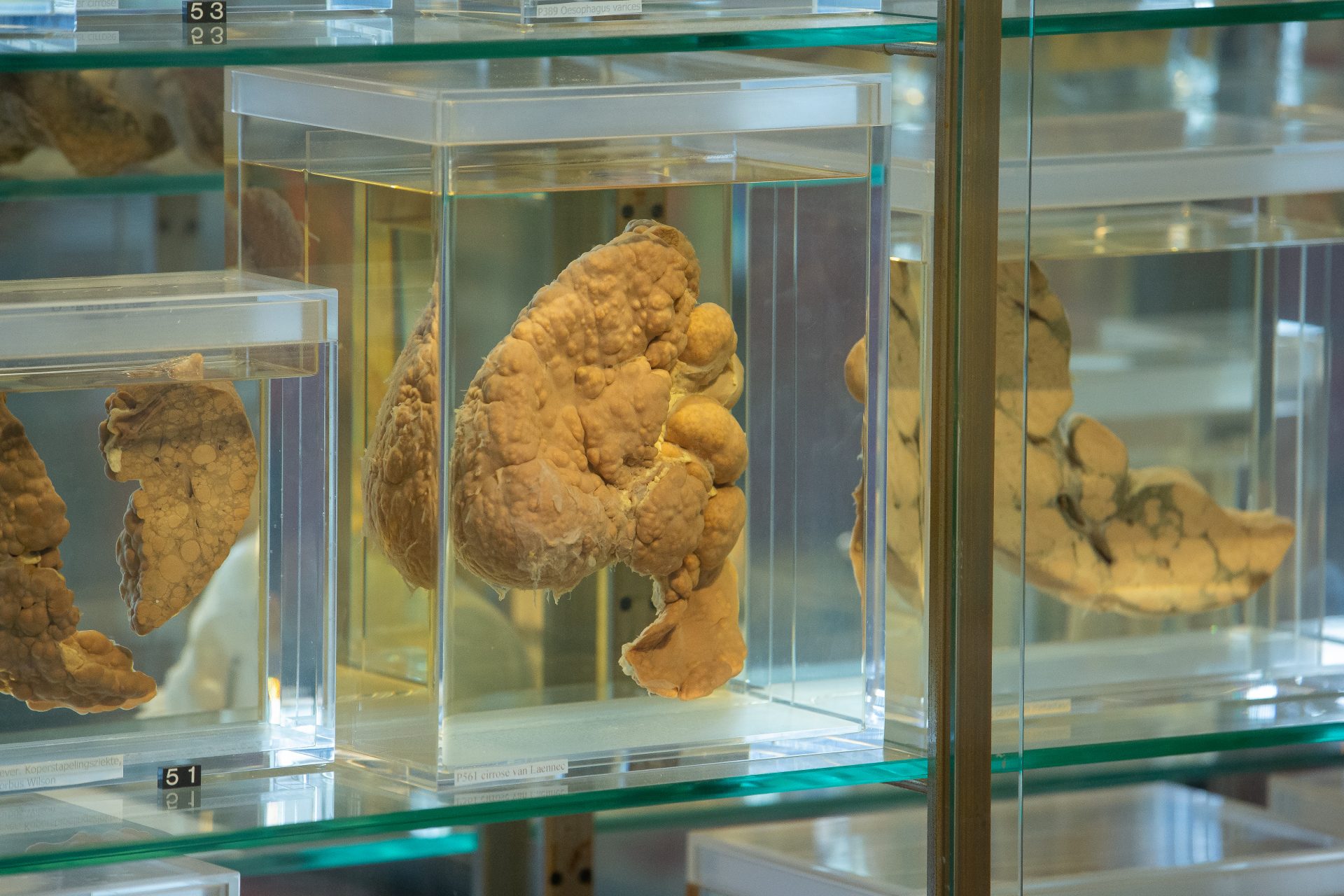Typhus, scurvy and Covid-19: diseases that made history
-
 Foto: David van Haren
Foto: David van Haren
From sudden infant death syndrome to kidney cancer, and from memory loss to Covid-19. The lustrum book ‘A Century of Diseases’ describes the most impactful diseases since the founding of Radboud University. ‘I am very interested in birth defects.’
A hundred different diseases, from scurvy to ADHD, lavishly illustrated with pictures of body parts from patients. That is what the layout of the book A Century of Diseases looks like: a book written by Dirk Ruiter, emeritus professor of Pathology; Lucas Boer, conservator of the Museum for Anatomy and Pathology at Radboudumc; and university historian Jan Brabers.
The book, written for Radboud University’s centenary, is dedicated to an interested lay audience, Ruiter and Boer explain in the museum. It can even be a gift for a graduation or for a general practice: it is for everyone who is interested in a brief overview of the most important diseases of the past hundred years.
Nobel Prize
Ruiter thoroughly investigated the diseases, Boer supplied the appropriate specimens, and Brabers filled in the story with some historical context: three elements that were added to all hundred descriptions.
The book touches on a range of diseases. How did you decide on this selection?
Ruiter: ‘We mainly looked at the impact of the diseases in the past hundred years. For example, due to a scientific highlight such as a Nobel Prize, but we also looked at the influence of the disease on society.’
‘For instance, take typhus. That is a disease which doesn’t have a high prevalence in normal conditions, but it was an epidemic in the concentration camps during the Second World War. Or take the founding of Alcoholics Anonymous in the 1930s; we could link that to an interesting story about alcohol-related liver diseases.’
But exactly a hundred diseases: that can’t be a coincidence.
Ruiter: ‘That’s right. The first eighty were quite straightforward. After that, I consulted my fellow emeriti at Radboud University. It was very important to us to establish a link with the researchers from Nijmegen, which was quite a challenge since the medical faculty wasn’t founded until 1951.’
‘Many illustrations in the book are specimens from the Museum for Anatomy and Pathology’
Boer: ‘In addition, I really wanted to include the Museum for Anatomy and Pathology. That is why many illustrations in the book are specimens from the museum. I notice that many employees that have worked here for years still have difficulty finding the museum, which is a pity. Hopefully, this book also helps increase the visibility of the museum.’
Were there any surprises? Diseases that you were unfamiliar with, or a historical aspect that was unknown to you?
Ruiter: ‘During the writing process you are certainly confronted with the facts. For example, Softenon was a remedy for morning sickness, but it led to malformations in thousands of babies. I was already familiar with that, but I didn’t know that a female doctor in America made sure that the remedy was prohibited there. Afterwards, she did receive prizes for her action. I was delighted to discover that.’
Boer: ‘I just happened to know that story, but that is because I am very interested in birth defects. For me, it was especially valuable to learn how this information can be incorporated into the museum in the future. I am not a great fan of info panels. But what’s the alternative? I think about that a lot.’

Just then, a group of high school students enters the museum, as they are taken on a guided tour by three medical students. The students are visibly and especially audibly excited, so we continue the conversation in the room with the pathological specimens. ‘This is more fitting to the content of the book’, Ruiter thinks out loud.
Glass of water
But it’s not long before the conservation is interrupted again, this time by the photographer: One of the students passed out in the museum. Boer smiles and explains that this happens from time to time. ‘It is great that people are interested in the specimens, but this is the risk that comes with it. Just give them a glass of water, and they often feel fine again. Where were we?’
What was the most interesting disease to you?
Boer: ‘Ataxia: a neurological disease that impairs muscle control and balance. We added a picture of a patient to the story in the book, whereas the other diseases are mostly supplemented by pictures of body parts. That works fine for internal diseases, but the patient is more abstract. But diseases are inseparable from those people afflicted with them. A picture of a patient makes that more vivid. I think that is why that story really gets me.’
‘When I wanted to cut open the stomach, it felt as if I was cutting into iron’
‘Oh, I enjoyed all the diseases’, Ruiter replies enthusiastically. Though he does tend to gravitate towards the cases he is familiar with. For instance, the book includes a case of a psychiatric patient who choked on her own vomit and passed away. ‘When I wanted to cut open the stomach, it felt as if I was cutting into iron.’
Once he managed to cut through the thick stomach lining, Ruiter stumbled on more than a kilo of ironware and broken glass. ‘This may sound like a unique case, but there are more situations in which patients swallow objects.’ And so, this case was awarded a spot in the book with the title ‘the glass and iron swallower’.
Suppose a new book is published in a hundred years: what diseases will we encounter then?
Ruiter: ‘That is hard to predict. There are many developments in health care, but we also put ourselves in positions to catch certain diseases. For instance, by travelling a lot, but also by putting animals together on a large scale, as is the case in factory farms. This can be life-threatening. What the world will look like in a hundred years is impossible to comprehend now, but it is a certainty that we will forever have to live with diseases.’
You can order the book ‘A Century of Diseases’ or download it for free via Radboud University Press.
Translated by Sophie Verhoeven



